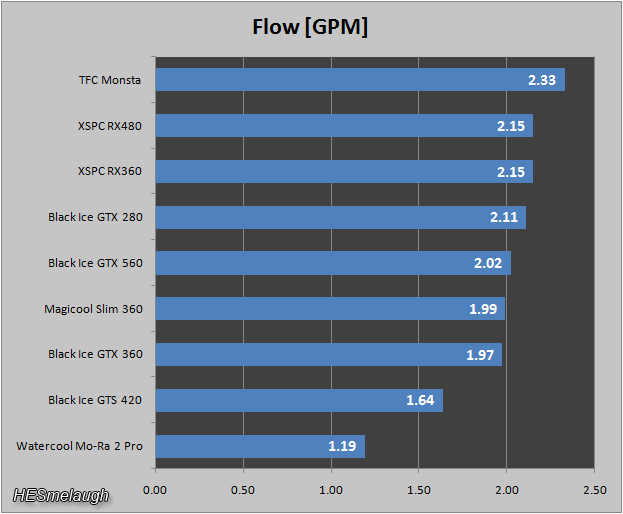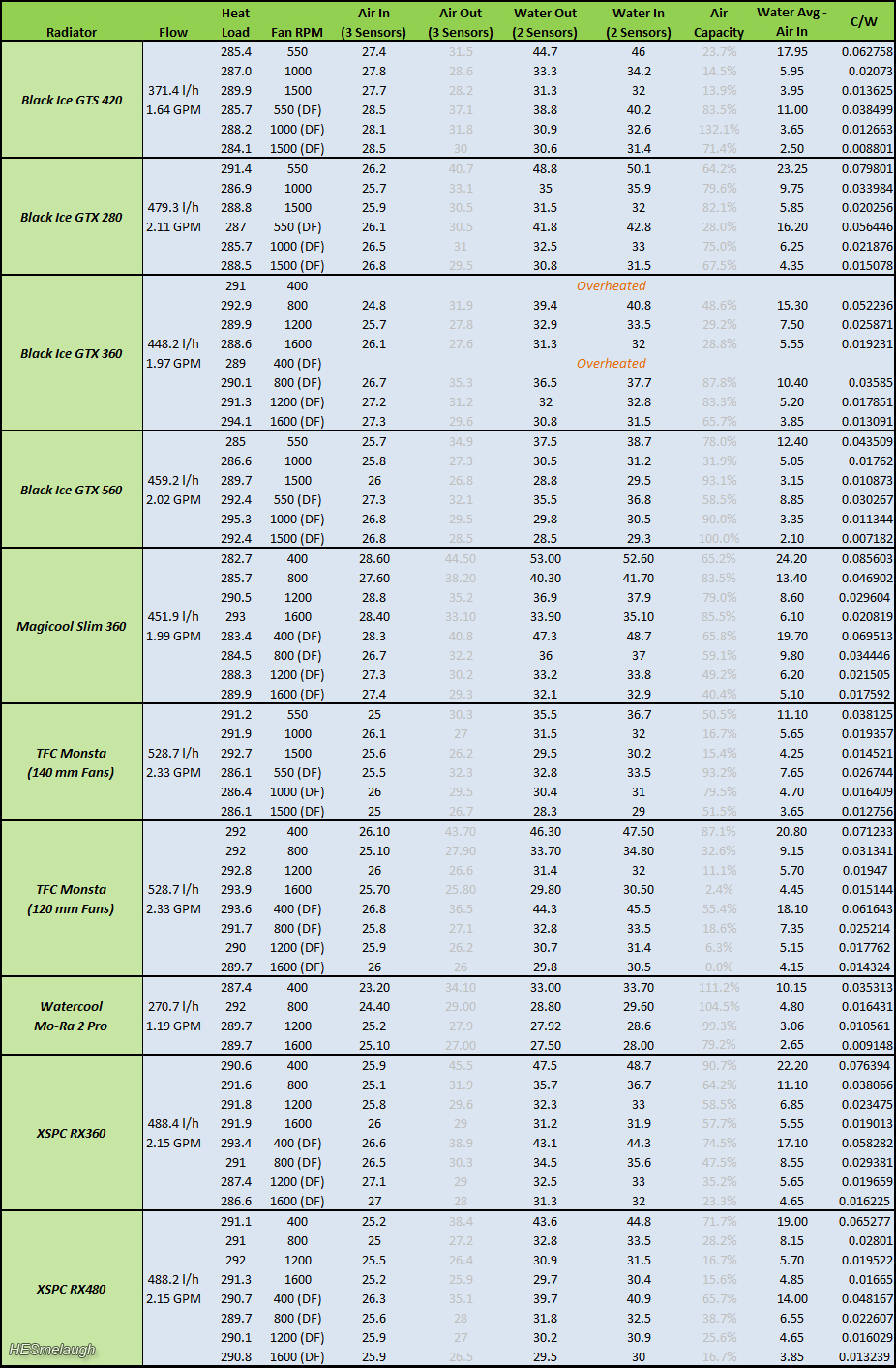After getting a chance to test the Black Ice GTX 560 quad 140 radiator against some triple-rads I was lucky enough to get my hands on some more radiators. With the TFC Monsta, Watercool Mo-Ra 2 Pro, Black Ice GTS 420 and XSPC RX480 the radiators in this roundup are mostly in about the same weight-class as the GTX 560.
Testing Method
Test-loop
- Laing DDC (MCP355) with EK X-Res
- 2x Inline heaters
- 4x Water-temp sensors
- 6x Air-temp sensors
- GMR flowmeter
- T-Balancer bigNG and Sensorhub for monitoring and logging temperatures amd flowrates
- Fans used: 120 mm Scythe Kama Flex 1900 and 140 mm Sharkoon System Fans
Each test run lasts 35 minutes, 25 minutes are warm up and the data from the last 10 minutes is all averaged out.
I don't control flowrates. The pump is always going at 12V and flow is as high as it can be in the loop. Just like the CPU blocks are tested with different flowrates due to differences in restrictiveness, I'm also testing radiators at "their own" flowrates, depending solely on their restrictiveness.
I do compare radiators of the 120-mm-format with those of 140-mm-format, even though such a comparison can never be 100% fair. The rads are being tested with different fans and (deliberately) different fan-speeds. Just keep in mind that the comparison can only be seen as a rough guide and different fans would (and do) lead to different results.
Now, let's get right to the good stuff...
Contestants



From left to right: Feser / TFC Monsta (huge, expensive, flashy - if you haven't heard of this, you must be new to liquid cooling), Black Ice GTS 420 (polar opposite to the Monsta: While sharing the 3x140 format, the GTS is very thin and has very tight fin-spacing), XSPC RX480 (4x120 rad from XSPC - the RX360 proved to be a great rad for low-speed fans), Watercool Mo-Ra 2 Pro (9x120 radiator, hugely popular in Germany for it's silent cooling capability).
Flow
The TFC Monsta proves to be very unrestrictive. Save for the GTS 420 and the Mo-Ra 2 Pro, I would say that all of these radiators are showing fairly good flowrates. The Mo-Ra 2 is by far the most restrictive of the radiators tested, which isn't much of a surprise, really.
CW, single row of fans, push
NOTE: The TFC Monsta allows for 140 mm fans as well as 120 mm fans to be attached. It is always represented with two sets of data, a "140" or "120" showing which fan size was used.
As you can see, this graph is very interesting, since there are trendlines crossing each other all over the place. Each time two trendlines cross, it means that one radiator is more suitable for higher fan speeds and the other is more suitable for lower fan speeds.
For example, we can see that the Monsta, using 140 mm fans offers better performance than the GTX 560 up until about 800rpm. At higher rpm, the GTX 560 becomes the better choice.
Similarly, we can see the XSPC RX480 out-doing the GTS 420 by a considerable margin at low fan speeds, but above about 900-1000rpm, the GTS 420 is in the lead.
And, comparing the very flat, very densely finned GTS 420 to the very thick, very loosely finned Monsta, we can see how these two radiator designs affect performance: The Feser Monsta offers superior performance up to about 1300rpm, after which the GTS 420 becomes slightly better.
Also worth noting is that the Monsta loses a huge amount of performance when it is equipped with 120 mm fans. With the smaller fans, the Monsta can barely keep up with the much more compact RX480 and is overtaken in performance by the GTS 420 at around 900rpm.
The only trendline that is never crossed is that of the Mo-Ra 2 Pro. This radiator simply offers astounding and superior cooling performance all the way from 400rpm to 1600rpm. At the top end of this range, the GTX 560 is coming close to it in terms of performance, though. It's possible that the GTX 560 will outpace the Mo-Ra at very high rpm. Keep in mind though, that the higher the fan rpm, the closer all values lie together. So even if the GTX 560 does outperform the Mo-Ra at, say, 3000rpm, it will most likely be only by a tiny margin.
CW, two rows of fans, push-pull
*The Mo-Ra 2 Pro cannot be equipped with two rows, or rather "walls" of fans in push-pull like the other radiators (and even if it could, there's a limit to how many identical fans of any type I have and that limit is below 18 ). Just out of curiosity, I added the performance data for the single row of fans on the Mo-Ra in with the data on push-pull for all the other fans. Keep this in mind as you're looking at the results.
With double the fans, the tightly finned Black Ice radiators gain a lot of performance. With this setup, the Monsta (six fans) can still hold it's own against the GTX 560 (eight fans) up to about 700rpm and against the GTS 420 (six fans) up to about 900rpm - after that, it's Black Ice territory.
It's also worth noting that the RX480, while being overtaken by the GTS 420 at relatively low rpm, comes pretty close to the Monsta's level of performance at high fan speeds in push-pull.
While it's interesting and amazing respectively to see the GTX 560 (with eight fans) and the GTS 420 (with six fans) surpassing the Mo-Ra's (nine fans) performance at medium to high fan speeds, the comparison is not quite fair, of course. With 18 fans in push-pull, the Mo-Ra would undoubtably be hard to beat.
CW, all radiators tested so far, single and double fans
As you can see, this one is pretty messy due to the sheer amount of data represented.
Data
Details on the individual radiators in the posts below.











 Reply With Quote
Reply With Quote






































 How long was it before they had problems with the rx480 rads? I getting mine from tom. He got them like a month ago or so. Maybe 1½.
How long was it before they had problems with the rx480 rads? I getting mine from tom. He got them like a month ago or so. Maybe 1½.
 Thanks for the review looks good. For my situation Monsta seems to be best rad as it fits in same spot as a 360 because the thickness doesn't matter and I am running cpu and 2 gpus with heatkillers off of it so it keeps the flow good!
Thanks for the review looks good. For my situation Monsta seems to be best rad as it fits in same spot as a 360 because the thickness doesn't matter and I am running cpu and 2 gpus with heatkillers off of it so it keeps the flow good!
 package. The reason it does well at all is it's shear size compared to the other rads.
package. The reason it does well at all is it's shear size compared to the other rads.




Bookmarks